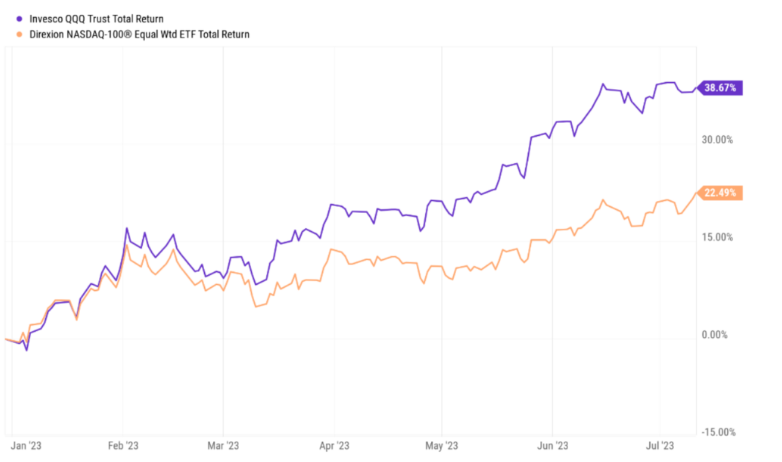

The Nasdaq 100 is often mentioned in financial media, but recently something quite rare happened.
On Monday 24 July, it went through a special rebalance.
This is only the third time this has happened since its launch in 1985 (the other times being December 1998 and May 2011).
So, what's prompted this?
The Nasdaq 100 index, which is often used to represent US Growth stocks, had become a bit too concentrated and needed to diversify its allocation.
The Nasdaq 100 is made up of the one hundred largest non-financial companies listed on the Nasdaq exchange.
As of 11 July 2023, seven companies made up more than 54% of its allocation:
- Microsoft (MSFT)
- Apple (AAPL)
- Amazon (AMZN)
- Google parent Alphabet (GOOG & GOOGL)
- Tesla (TSLA)
- Nvidia (NVDA)
- Meta (META) formerly known as Facebook
Previously known as the "FAANG" stocks, they were later modified and rebranded as the "MAMAA" stocks, and now they're known as the "Magnificent Seven."
These companies have been (and continue to be) incredibly influential on a global scale. They touch so many parts of the economy and our everyday lives. Their influence on investment returns at the index level has also been particularly significant in 2023.
Look at the difference between these two ETFs in the chart below:
- The '$QQQ' (purple line) follows the performance of the standard, cap-weighted Nasdaq 100 Index. In a cap-weighted index, the weight of each individual stock in the index is determined by its market capitalisation. This means that larger companies have a higher influence on the index's performance.
- The '$QQQE' (orange line) is another ETF that tracks the Nasdaq 100 Index, but with a different approach. This ETF represents the equal-weighted Nasdaq 100, meaning that each of the 100 companies in the index has the same weight or importance regardless of their market capitalisation.
As of 11 July, $QQQ has outperformed $QQQE by +16% so far this year. This is because it's heavily allocated to the “Magnificent Seven”.
YTD total returns (30 December 2022 - 11 July 2023)

Source: YCharts
Equal Weight indices (like the orange line here) usually offer a better view into how the “average” stock in the index is performing.
The mega-cap Tech stocks have experienced remarkably high returns and are significantly outperforming the average stock within the index.
Due to its cap-weighting methodology, the allocations to the "Magnificent Seven" stocks have expanded to concerning levels within the index.
This is the reason for the special, one-time rebalance this week (in addition to its recent standard quarterly rebalance). Their allocations within the index have simply grown too much.
Isn't outperformance a good thing?
Outperformance is great.
Being overconcentrated is problematic.
The Securities and Exchange Commission (SEC) has specific diversification rules that registered investment companies, which includes publicly traded index ETFs, must follow. Since one of the goals of buying a passive index ETF is to gain diversified exposure to broad markets via a single investment product, the SEC has limits on the aggregate weights of the largest stock holdings for those products.
The providers of the Nasdaq 100 also have their own rules and limits, aimed at stopping them violating SEC regulations. If the combined total of positions that have at least a 4.50% individual weight inside the index, exceed 48% of the total index’s allocation, action must be taken. At about 54%, the index has hit this limit.
A “passive” index is making an “active” decision to reduce risk and its exposure to the best-performing positions by increasing its diversification. That’s pretty rare!
What should investors do?
If you own the $QQQ
Your ETF will rebalance automatically (because the index itself is making changes).
If you own the individual stocks
Maybe now is the time to diversify. These holdings might have helped your recent performance, but you are likely highly overallocated.
Of course, this is your choice.
The decision depends on the specific circumstances of your financial plan.
But if the Nasdaq 100, a passive index, has taken an active approach to risk management, it's probably wise to consider doing the same to boost your diversification and reduce your overall risk profile.
Diversification is vital for managing risk and adding protection to your portfolio.
This might sound odd, but you should always have at least one investment or strategy in your portfolio that’s underperforming at all times. As Matt Hall, author of Odds On might say, it's about owning the haystack, not looking for the shiny needle in it.
When the market drops, which it will, you should be so diversified that it won't matter.
If you're a DIY investor or your current adviser is overexposing you to concentration risk...
Maybe it’s time for a second opinion.
Neither you or your adviser should be so focused on the possibilities of outsized portfolio returns that the risks to your long-term financial plan are ignored.

